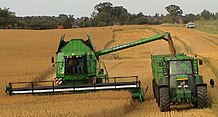Draft:IoT in Agriculture
| Submission declined on 29 May 2024 by CanonNi (talk). This submission is not adequately supported by reliable sources. Reliable sources are required so that information can be verified. If you need help with referencing, please see Referencing for beginners and Citing sources. This draft's references do not show that the subject qualifies for a Wikipedia article. In summary, the draft needs multiple published sources that are:
Where to get help
How to improve a draft
You can also browse Wikipedia:Featured articles and Wikipedia:Good articles to find examples of Wikipedia's best writing on topics similar to your proposed article. Improving your odds of a speedy review To improve your odds of a faster review, tag your draft with relevant WikiProject tags using the button below. This will let reviewers know a new draft has been submitted in their area of interest. For instance, if you wrote about a female astronomer, you would want to add the Biography, Astronomy, and Women scientists tags. Editor resources
|  |
 Comment: All sources are about SEO (?); unrelated to the topic. '''[[User:CanonNi]]''' (talk • contribs) 09:02, 29 May 2024 (UTC)
Comment: All sources are about SEO (?); unrelated to the topic. '''[[User:CanonNi]]''' (talk • contribs) 09:02, 29 May 2024 (UTC)
Introduction to IoT in Agriculture[edit]
The Internet of Things (IoT) refers to the interconnection of computing devices embedded in everyday objects, enabling them to send and receive data. In agriculture, IoT technologies have revolutionized farming practices by providing real-time data, automating processes, and improving efficiency.
Robots and Autonomous Machines in Agriculture[edit]
Definition and Overview[edit]

Robots and autonomous machines are advanced technological tools designed to automate agricultural tasks such as planting, weeding, pesticide application, and harvesting. These machines are equipped with sensors, cameras, and GPS systems to perform tasks with high precision and minimal human intervention.
Applications in Farming[edit]
- Planting and Harvesting: Autonomous tractors and harvesters can plant seeds and harvest crops with precision, reducing labor costs and increasing productivity.
- Weeding and Pest Control: Robotic weeders and drones equipped with cameras and sprayers can identify and eliminate weeds and pests efficiently.
Benefits of Robotics in Agriculture[edit]
- Increased Efficiency: Robots can operate continuously and perform repetitive tasks faster than human labor.
- Cost Savings: Reduces the need for manual labor and minimizes resource wastage.
- Sustainability: Precise application of inputs such as water and pesticides reduces environmental impact.
Cattle Monitoring and Management with IoT[edit]
Overview of Cattle Monitoring[edit]
Cattle monitoring systems use IoT devices like smart collars and ear tags to track the health, behavior, and location of livestock. These devices collect data on vital signs, movement, and feeding patterns, which is transmitted to farmers for analysis.

IoT Solutions for Cattle Management[edit]
- Health Monitoring: Devices track vital signs and detect early signs of illness, enabling timely intervention.
- GPS Tracking: Ensures livestock are accounted for, reducing losses and preventing theft.
- Automated Feeding: Systems provide precise nutrition based on the individual needs of each animal.
Benefits and Impacts[edit]
- Improved Animal Welfare: Continuous monitoring helps detect health issues early, ensuring prompt treatment.
- Increased Productivity: Optimized feeding and health management lead to better growth rates and higher yields.
- Labor Savings: Automates many aspects of livestock management, reducing the need for constant human oversight.
Comparison of Robotics and Cattle Monitoring IoT in Agriculture[edit]
Purpose and Scope[edit]
- Robotics: Focuses on automating crop-related tasks to improve efficiency and precision in farming operations.
- Cattle Monitoring: Aims to optimize livestock health and management through real-time monitoring and data analysis.
Applications in Agricultural Operations[edit]
- Robotics: Used in various stages of crop production including planting, weeding, and harvesting.
- Cattle Monitoring: Utilized for health tracking, location monitoring, and automated feeding of livestock.
Principles and Characteristics[edit]
- Robotics: Emphasizes automation, precision, and scalability.
- Cattle Monitoring: Prioritizes real-time data collection, animal welfare, and integration with other farm management systems.
Conclusion[edit]
IoT technologies such as robots and autonomous machines, and cattle monitoring systems are transforming agriculture by enhancing efficiency, productivity, and sustainability. As these technologies continue to advance, they hold immense potential for addressing global food security challenges and fostering a more resilient farming ecosystem.
References[edit]
- ^ "How to Write Content Outlines for SEO — Plus a Free Outline Template". www.growthmachine.com. Retrieved 2024-05-29.
- ^ Widmer, Bill (2022-06-03). "Content Outlines: How to Write Better Content Faster". SEO Blog by Ahrefs. Retrieved 2024-05-29.
- ^ "The Only Article Outline Template You'll Use (SEO Focused)". www.lucianowrites.com. Retrieved 2024-05-29.
- ^ "6 steps to writing amazing content outlines fast [Template] | Marketer Milk". www.marketermilk.com. Retrieved 2024-05-29.
- ^ "🔥 How to Create a Killer Content Outline (+ Template)". https://www.flow-seo.com/. Retrieved 2024-05-29.
{{cite web}}: External link in|website= - ^ "How to Write an Effective SEO Blog Outline (+Free Template Example)". contenthacker.com. 2022-05-06. Retrieved 2024-05-29.
